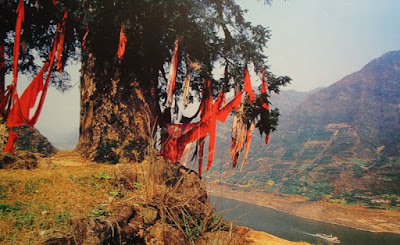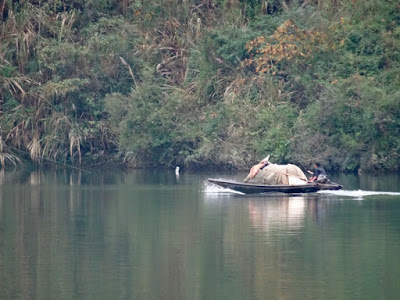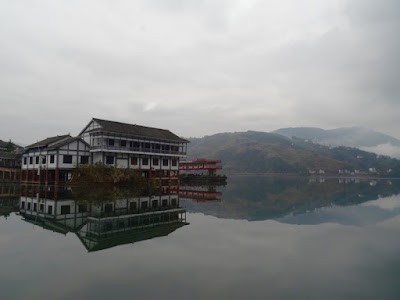Cruising on the Yangtze River, above the famous Yangtze River Dam.
"The Three Gorges Dam is the world’s largest hydropower project. The massive project sets records for number of people displaced (more than 1.2 million), number of cities and towns flooded (13 cities, 140 towns, 1,350 villages), and length of reservoir (more than 600 kilometers). The project has been plagued by corruption, spiraling costs, environmental impacts, human rights violations, resettlement difficulties and security.
The Government’s goals for the project, commenced in 1994 and completed 2009, were for flood control, power generation, navigation and tourism."
Continuing on from China - Part 3 to Day 7. First some info about how the Yantze looked before 1994.
When we disembarked from our cruise boat, at Chongqing 2 days later, we were taken to the Ghongqing Three Gorges Museum. Like the dam project, the museum was an engineering master piece and required more than our 2 allocated hours, to fully comprehend and appreciate all the information presented.
As we had sailed along the Yangtze, I had tried to imagine what the Yangtze had looked like prior to 1994. In the museum, I took photographs of the photos on display, taken pre 1994.
Over the centuries innumerable lives have been lost to the river, as navigation was so difficult. 'River Trackers', on the banks, hauled the boats through the very difficult areas.
I just had to include this photo and caption.
Day 7
This saw us continuing to enjoy the spectacular scenery of the phenomenal Zangtze River, even though the day had again dawned grey. As we completed breakfast, the 'Katerina' moored in Badang, population 1 million. Soon after, we swapped the 'Katerina' for a swifter, smaller boat, which took us along the side gorge of Shennong Stream. It was isolated, the mountains dwarfed us, the river was mirror still, the vegetation reflected lush and green and it was chilly throughout our 3 hour visit. Very few however, left the railings of the boat. It was magical.
This saw us continuing to enjoy the spectacular scenery of the phenomenal Zangtze River, even though the day had again dawned grey. As we completed breakfast, the 'Katerina' moored in Badang, population 1 million. Soon after, we swapped the 'Katerina' for a swifter, smaller boat, which took us along the side gorge of Shennong Stream. It was isolated, the mountains dwarfed us, the river was mirror still, the vegetation reflected lush and green and it was chilly throughout our 3 hour visit. Very few however, left the railings of the boat. It was magical.
Entering Shennong Stream.
Another hanging coffin.
Bridge building - surely the previous bridge wasn't built using this style of scaffolding.
"These are some peanuts from my hometown. I hope you will like it. Lily"
This what greeted my husband and I when we returned to our cabin on the Katerina. No-one else was as fortunate in their house maid as we were.
On our return, lunch was partaken of quickly, so as not to miss any of the breathtaking scenery.






















On our return, lunch was partaken of quickly, so as not to miss any of the breathtaking scenery.
Entering Wu Gorge - famous for its elegance as it winds 25 miles between towering mountains.


Elegance a tad spoilt by coal mining, which occurred a number of times.



The 'Goddess Peak' [middle]

Note the white line on the middle mountain.

Ditto

This closer view shows it as a newly constructed road!
One of 2 boat landings to enable one to hike up to the Goddess Peak, 6 to 8 hours.

Wu Gorge completed. New shoreline vista's.

Entering Qutang Gorge - shortest, narrowest and deepest.





View back to Qutang Gorge. This view is found on the 10 yen note.

20 mins after exiting Qutang Gorge we tripled birthed with 2 other cruise boats at Fengjie. Unless one had paid to visit the Baidicheng White Emperor City, one had to stay on board.
We were highly entertained by the locals selling fruit and seafood from their small craft to mainly crew, but also to guests on the cruise boats........
The orange man arriving. He sold out.

Seafood - shrimps and dried fish.
A selection is placed in a plastic bag, hooked to a long bamboo pole and hoisted to the balcony of the intended purchaser.

It is checked out. If bought, money is added to the bag.


It looked edible in winter, but once the temperature rises.................


The following morning, day 8, found us mooring at the small town of Baoshi, home of the Shibaozhai Pagoda or Precious Stone Fortress. The temple rests on a rocky crag of about 200 metres. Initiated by Emperor Qianlong in 1750, it was adapted in 1819 and in 1956. In the 1990's work had to be done to protect it from the rising Zangtze.
The 'Drunken Bridge' [suspension] now provides access to the island.
Daily life for many. So many contrasts in this country.
Sorry, that this has become an awfully long post, but the tiny window of China that we experienced, held just so much history, beauty and wonder, that it has been difficult to know how much to share.
I would love to read your comment.















































You really got to see the heart of China. I enjoyed your photos of the fabulous scenery and glimpses of the locals.
ReplyDeleteAmazing scenery. The Yangtze is one mighty river!
ReplyDeleteChina is indeed a country of huge contrasts.
ReplyDeleteThe river views are magnificent. It's always lovely to see how beautiful the Earth is, but for some strange reason I enjoy also seeing big bridges. :)